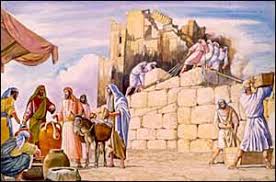Cyrus Decrees: Rebuild the Temple
Ezra 1: 1-11
Compiled by the Chronicler from the Ezra memoirs
(to see link click Ac – Ezra-Nehemiah From a Jewish Perspective: The Ezra Memoirs).

It had been nearly seventy years since the first deportation of Jews by the Babylonians to Mesopotamia (see the commentary on Jeremiah, to see link click Gt – In the Thirty-Seventh Year of the Exile Jehoiachin was Released from Prison). Though the initial years were surely difficult, the second and third generations of Jews born in the exile had adjusted to their surroundings. Most had become so comfortable that they refused to return to Judah when given the opportunity, others prayed for and desired to return.12 They longed to worship ADONAI together and offer sacrifices in their own Temple according to their own Torah and traditions. So the chapters of Ezra tell the story of the second exodus, one of the most important events in Jewish history, and thus in God’s redemptive plan.13
Isaiah prophesied that Jews would return and rebuild the Temple in Jerusalem two-hundred years before Cyrus was born (see the commentary on Isaiah Ia – The Deliverance by Cyrus the Great). So in 538 BC when the Babylonian empire passed from Belshazzar to Cyrus king of Persia, also known as Darius the Mede (see the commentary on Daniel Ag – Cyrus and Darius), the new king’s first act was to appease the Jewish population by reversing the policy of his predecessors. The kings of Babylon had been in the habit of forcibly removing conquered people and transplanting them in other desolate regions of the empire, or within the walls of Babylon. The new policy served the double purpose of removing a dangerous source of hostility from the center of the empire, and dispersing grateful subjects into every quarter of the dominion. The Jews were not the only people to benefit, but they probably appreciated it more than any other subject nation.



Leave A Comment